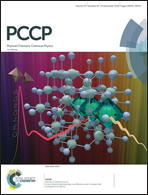Significant structural relaxations of excited [n]cycloparaphenylene dications (n = 5–9)†
Abstract
Hoop-shaped macrocycles such as cycloparaphenylenes ([n]CPPs, where n denotes the number of phenylene rings) have attracted considerable attention in recent years because of their interesting properties arising from the highly strained aromatic structure and radially oriented p-orbitals. While the radical cation and dication states of [n]CPPs have been characterized, there is no information available about their excited states, which are expected to exhibit enhanced redox properties. In this study, we investigated the S1 state of [n]CPP2+ by transient absorption measurements in the visible and near-IR regions. The energy of the transient absorption peak exhibited a linear relationship with the reciprocal of the repeating unit, which indicated that the distribution of the excited state expanded with the size of the ring. In addition, smaller CPP2+s showed longer excited state lifetimes. Theoretical calculations suggested that there was a substantial structural relaxation of the smaller CPP2+s accompanying the changes in the charge distribution. Therefore, it was concluded that the smaller Franck–Condon factor resulting from the considerable structural change and larger S1 energy were responsible for the longer S1 state lifetime of smaller CPP2+s.
![Graphical abstract: Significant structural relaxations of excited [n]cycloparaphenylene dications (n = 5–9)](/en/Image/Get?imageInfo.ImageType=GA&imageInfo.ImageIdentifier.ManuscriptID=C8CP04860F&imageInfo.ImageIdentifier.Year=2018)


 Please wait while we load your content...
Please wait while we load your content...